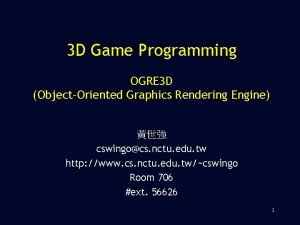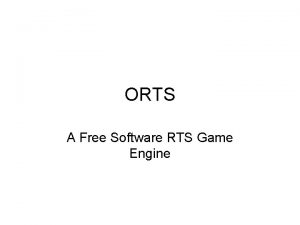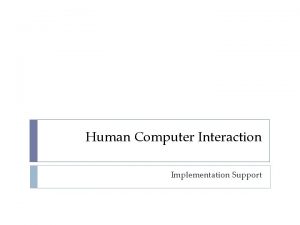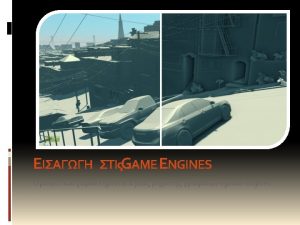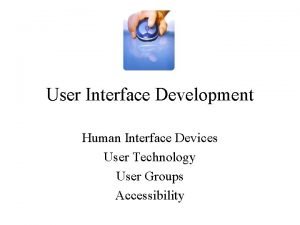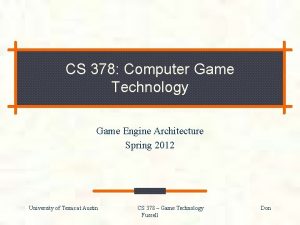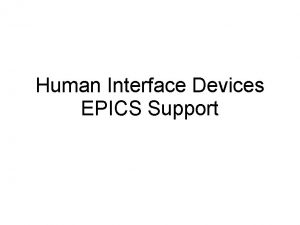Game Engine Architecture Chapter 8 Human Interface Devices






























- Slides: 30

Game Engine Architecture Chapter 8 Human Interface Devices

Overview • • • Types of input devices Interfacing with a HID Types of input Types of output Game engine HID systems

Types of HIDs • • Consoles typically come with a Joypad device Computers often use the keyboard and mouse Arcade games have very specialized input Many specialized devices o Guitar Hero o Dance Revolution • Modifiers on existing devices o Steering wheel for Wii. Mote

Types of hids

Interfacing to a HID • Depends on the device • Polling – reading the state once per iteration o Hardware register o Memory mapped I/O port o Using a higher level function • XInput on the XBox 360 is a good example o Call XInput. Get. State() which returns a XINPUT_STATE struct

Interfacing • Interrupts o Triggered by a state change in the hardware o Temporarily interrupts the CPU to run a small piece of code • Interrupt Service Routine (ISR) o ISRs typically just read the change and store the data • Wireless o o Many of the wireless controllers use Bluetooth to communicate Software requests HID state Usually handled by a separate thread Looks like polling to the application developer

Type of input • Digital Buttons o o Have two states Pressed represented by a 1 Not pressed represented as a 0 Depends on the hardware developer • Often the button state is combine into one struct

Xinput_gamepad typedef struct _XINPUT_GAMEPAD { WORD w. Buttons; BYTE b. Left. Trigger; BYTE b. Right. Trigger; SHORT s. Thumb. LX SHORT s. Thumb. LY SHORT s. Thumb. RX SHORT s. Thumb. RY } • x. Buttons contains the state of all the buttons and you apply masks to get their current state o (pad. w. Buttons & XINPUT_GAMEPAD_A) != 0

Analog axes and buttons • Unlike buttons, joysticks have a range of values • They aren’t truly analogy because they are digitized o Range from -32, 768 to +32, 767 o or -1 to +1 • In the Xbox XINPUT structure the joysticks are represented using 16 -bit signed integers

Relative axes • Most of the time the position of the trigger, joystick, or thumb stick is absolute – relative to a 0, 0 point • Some input devices provide information in a relative format o They return 0 if the device has not moved from its past position • Examples include mice, mice wheels, and track balls

Accelerometers • Newer controllers have accelerometers built in • These provide information about g-force in three directions • Can measure up to 3 g • These are relative measures – when not accelerating the return is 0

Wii. Mote and Dual. Shock • One issue is that the accelerometers don’t give you orientation information • One way to do it is to remember that gravity has 1 g of force in the downward direction • If the player holds the device still, you can calibrate the device based on which axis is experiencing 1 g of force

Cameras • The Wii uses a very low resolution IR camera to read the location of the Wii. Mote o Wii. Mote has two IR leds • The distance between the two dots, the size of the dots, and the relative position of the dots provides a lot of information about where the mote is pointing • Other examples include the Sony Eye. Toy and Xbox Kinect

Camera input

Types of output • Rumble o Usually one or two motors with a unbalanced weight o Can control the speed to create different feels • Force feedback o A motor attached to the HID that resists input from the user • Audio o Wii. Mote has low-quality speaker o Dual. Shock 4, Xbox 360 and Xbox One controllers have headphone jack • Others o Some have LEDs that can be controlled via software

Game HID systems • Most game engine massage the data coming in from the controllers o o Allows for player remapping Smooth control Chords Sequences

Typical requirements • • • Dead zones Analog signal filtering Event detection Detection of sequences and chords Gesture detection Management of multiple HIDs Multiplatform HID support Controller input re-mapping Context sensitive inputs The ability to disable certain inputs

Dead zones •

Analog signal filtering • filtered unfiltered

Low-pass filter F 32 low. Pass. Filter(F 32 unfiltered. Input, F 32 last. Frames. Filtered. Input, F 32 rc, F 32 dt) { F 32 a= dt / (rc +dt); return (1 -a) * last. Frames. Filtered. Input + a * unfiltered. Input; }

Moving average • An equally interesting way of filtering the data is to use a moving average • This can be done using a circular queue that maintains the last n values • You can also keep the running sum by adding the new value and subtracting the one it is replacing in the queue

Input event detection • The easiest way to detect a change to states is to keep the previous state and XOR it with the current state o XOR produces a 1 when the state has changed • We can then mask out the up events and the down events by using AND o ANDing the original state with the changed state gives us the DOWNs o NANDing gives us the UPs

Chords • Chords are combinations of button presses o A+B at the same time • Easy to create masks for chords, but there are some subtle issues o Users aren’t perfect in the timing of the presses o The code must be robust to not triggering the non-chord events too • Lots of ways to resolve these o Design button inputs so the chord does the individual actions plus something else o Introduce a delay in processing individual inputs so a chord can form o Wait for button release to start an event o Start a single button move right away and override it with a chord move

Sequences and gestures • Sequences are usually done by storing the input events and tagging them with time • When the next button is pressed, determine if the time for the sequence has expired or if the sequence is invalid • Can be used for o Rapid button tapping o Button sequences o Thumb stick rotations • Good sample code in the book for all of these

Multiple HIDs • This just involves mapping the correct input to the correct player • Also involves detecting HID changes due to serious events o Controller unplugged o Batteries dying o Player being assaulted

Cross platform HIDs • Two main ways to handle this o Conditional compilations – YUCK messy code • Hardware abstraction layer o Create your own input classes and add a translation layer o Certainly superior because it is easy to add new HIDs

Input re-mapping • We can provide a very nice feature by adding in a few classes that create a level of indirection – input remapping • If we give names to events that have nothing to do with the input that triggers it, then we simple create an input to event lookup table • Requires us to normalize the input a bit o Think about keyboard versus mouse for aircraft control

Context sensitive controls • Often the controls will trigger different events based on the situation o The “use” button is a classic case • One way to implement this is to use a state machine o In state “walking” L 1 means fire primary weapon o In state “driving” L 1 means turbo • When mixed with user re-mapping the system can become quite complex

Disabling inputs • One simple, but Draconian approach is to introduce a mask o When a control is disabled, set the bit to 0 o The mask is then ANDed with the control input before further process • Make sure the bit gets set back to 1 again otherwise you loose control forever • Sometimes you want to disable it for a particular set of actions, but other systems might want to see it. . .

In practice • It takes a serious amount of time and effort to build an effective HID system. • It is super important because it radically affects game play
 Game engine architecture
Game engine architecture Game engine architecture
Game engine architecture External vs internal combustion engine
External vs internal combustion engine Rustici software llc
Rustici software llc Pisa server
Pisa server What is interface in java
What is interface in java User led through interaction via series of questions
User led through interaction via series of questions Industrial interfaces
Industrial interfaces Interface------------ an interface *
Interface------------ an interface * Sustainable and green engines
Sustainable and green engines Ogre game engine tutorial
Ogre game engine tutorial Rts game engine
Rts game engine Acid game engine
Acid game engine Gii game engine
Gii game engine Unreal engine game loop
Unreal engine game loop Core game maker
Core game maker Renderware engine tutorial
Renderware engine tutorial Torque script
Torque script Flame game engine
Flame game engine Search engine architecture in information retrieval
Search engine architecture in information retrieval Matching engine architecture
Matching engine architecture Architecture of a search engine
Architecture of a search engine Search engine architecture
Search engine architecture Promotion engine as a service
Promotion engine as a service Cell broadband engine architecture
Cell broadband engine architecture Csuva
Csuva Enterprise architect interface
Enterprise architect interface Programming toolkits in hci
Programming toolkits in hci Programmed i/o in computer architecture
Programmed i/o in computer architecture 3340705
3340705 Jbufs
Jbufs










